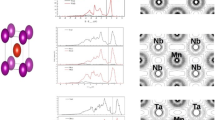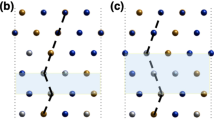Abstract
Ab initio calculations are used to understand the fundamental mechanism of the solid solution softening/hardening of the Mo-binary system. The results reveal that the Mo-Ti, Mo-Ta, Mo-Nb, and Mo-W interactions are primarily attractive with negative heats of formation, while the interactions of Mo-Re, and Mo-Zr would be mainly repulsive with positive heats of formation. It is also shown that the addition of Re and Zr would cause the solid solution softening of Mo by the decrease of the unstable stacking fault energy and the increase of ductility. On the contrary, the elements of W, Ta, Ti, and Nb could bring about the solid-solution hardening of Mo through the impediment of the slip of the dislocation and the decrease of ductility. Electronic structures indicate that the weaker/stronger chemical bonding due to the alloying elements should fundamentally induce the solid solution softening/hardening of Mo. The results are discussed and compared with available evidence in literatures, which could deepen the fundamental understanding of the solid solution softening/hardening of the binary metallic system.
摘要
用第一性原理计算方法研究了钼二元系固溶体软化/硬化的基本机理。 结果表明, Mo-Ti、 Mo-Ta、 Mo-Nb 和 Mo-W 之间的作用主要是相互吸引, 具有负的生成热, 而 Mo-Re 和 Mo-Zr 之间的作用主要是相互排斥, 具有正的生成热。 Re 和 Zr 的加入会降低钼的堆垛层错能, 提高合金的塑性, 从而导致钼的固溶软化;而 W、 Ta、 Ti、 Nb 等元素通过阻碍位错滑移和塑性下降, 使 Mo 固溶硬化。 电子结构表明, 合金元素导致的弱/强化学键合从根本上诱导了钼的固溶体软化/硬化。 本文对计算结果进行讨论, 并与文献中已有的证据进行了分析比较, 加深了对二元金属体系固溶体软化/硬化的基本认识。
Similar content being viewed by others
References
LIU G, ZHANG G J, JIANG F, DING X D, SUN Y J, SUN J, MA E. Nanostructured high-strength molybdenum alloys with unprecedented tensile ductility [J]. Nature Materials, 2013, 12(4): 344–350. DOI: https://doi.org/10.1038/NMAT3544.
SCHNEIBEL J H, TORTORELLI P F, RITCHIE R O, KRUZIC J J. Optimization of Mo-Si-B intermetallic alloys [J]. Metallurgical and Materials Transactions A, 2005, 36: 525–531. DOI: https://doi.org/10.1007/s11661-005-0166-4.
YU J L, LI Z K, ZHENG X, ZHANG J J, LIU H, BAI R, WANG H. Tensile properties of multiphase Mo-Si-B refractory alloys at elevated temperatures [J]. Materials Science & Engineering A, 2012, 532(15): 392–395. DOI: https://doi.org/10.1016/j.msea.2011.11.001.
ZHANG C, GAO M C, YANG Y, ZHANG F. Thermodynamic modeling and first-principles calculations of the Mo-O system [J]. Calphad, 2014, 45: 178–187. DOI: https://doi.org/10.1016/j.calphad.2013.12.006.
DIMIDUK D M, PEREPEZKO J H. Mo-Si-B Alloys: Developing a revolutionary turbine-engine material [J]. MRS Bulletin, 2003, 28(9): 639–645. DOI: https://doi.org/10.1557/mrs2003.191.
TOTEMEIER T C, WRIGHT R N, SWANK W D. FeAl and Mo-Si-B intermetallic coatings prepared by thermal spraying [J]. Intermetallics, 2004, 12(12): 1335–1344. DOI: https://doi.org/10.1016/j.intermet.2004.04.034.
SUPATARAWANICH V, JOHNSON D R, LIU C T. Effects of microstructure on the oxidation behavior of multiphase Mo-Si-B alloys [J]. Materials Science & Engineering A, 2003, 344(1, 2): 328–339. DOI: https://doi.org/10.1016/S0921-5093(02)00446-X.
BYUN T S, LI M, COCKERAM B V, SNEAD L L. Deformation and fracture properties in neutron irradiated pure Mo and Mo alloys [J]. Journal of Nuclear Materials, 2008, 376(2): 240–246. DOI: https://doi.org/10.1016/j.jnucmat.2008.03.004.
EL-GENK M S, TOURNIER J M. A review of refractory metal alloys and mechanically alloyed-oxide dispersion strengthened steels for space nuclear power systems [J]. Journal of Nuclear Materials, 2005, 340(1): 93–112. DOI: https://doi.org/10.1016/j.jnucmat.2004.10.118.
LEONHARDT T, CARLEN J C, BUCK M, BRINKMAN C R, REN W, STEVENS C O. Investigation of mechanical properties and microstructure of various molybdenumrhenium alloys [C]// AIP Conference Proceedings. 1999: 685–690. DOI: https://doi.org/10.1063/1.57638.
ALOUANI M, ALBERS R C, METHFESSEL M. Calculated elastic constants and structural properties of Mo and MoSi2 [J]. Physical Review B, 1991, 43(8): 6500–6509. DOI: https://doi.org/10.1103/PhysRevB.43.6500.
PEREPEZKO J H. The hotter the engine, the better [J]. Science, 2009, 326: 1068–1069. DOI: https://doi.org/10.1126/science.1179327.
ZHAO J, LIU L C, GONG H R, GONG X. Cohesion strength and fracture toughness of Mo-TiC interfaces [J]. Surface and Coatings Technology, 2019, 382: 125158. DOI: https://doi.org/10.1016/j.surfcoat.2019.125158.
PARASCHIV A, MATACHE G, PUSCASU C, GRIGORESCU M. A correlation between fracture toughness and cohesion strength of molybdenum thermal sprayed coatings [J]. MATEC Web of Conferences, 2018, 145: 02007. DOI: https://doi.org/10.1051/matecconf/201814502007.
CAI Zhen-yang, LIU S, XIAO L, FANG Z, LI W, ZHANG B. Oxidation behavior and microstructural evolution of a slurry sintered Si-Mo coating on Mo alloy at 1650 °C [J]. Surface and Coatings Technology, 2017, 324(15): 182–189. DOI: https://doi.org/10.1016/j.surfcoat.2017.05.054.
OUYANG G Y, RAY P K, THIMMAIAH S, KRAMER M J, AKINC M, RITT P, PEREPEZKO J H. Oxidation resistance of a Mo-W-Si-B alloy at 1000–1300 °C: The effect of a multicomponent Mo-Si-B coating [J]. Applied Surface Science, 2019, 470(15): 289–295. DOI: https://doi.org/10.1016/j.apsusc.2018.11.167.
KUMAR N K, MITRA R, DAS J. Effect of moist environment on the oxidation behavior of Mo76-Si14B10Fe (x=0, 0.5, 1 at.%) ultrafine composites in the range of 700–800°C [J]. Corrosion Science, 2019, 155: 86–96. DOI: https://doi.org/10.1016/j.corsci.2019.04.032.
CAI Z, WU Y, LIU H, TIAN G Y, PU R, PIAO S M, TANG X Y, LIU S N, ZHAO X J, XIAO L R. Formation and oxidation resistance of a new YSZ modified silicide coating on Mo-based alloy [J]. Materials & Design, 2018, 155: 463–474. DOI: https://doi.org/10.1016/j.matdes.2018.06.011.
XI H H, HE P F, WANG H D, LIU M, CHEN S Y, XING S G, MA J Z, LV Z L. Microstructure and mechanical properties of Mo coating deposited by supersonic plasma spraying [J]. International Journal of Refractory Metals and Hard Materials, 2019, 86(7): 193–201. DOI: https://doi.org/10.1016/j.ijrmhm.2019.105095.
DENG X K, ZHANG G J, WANG T, REN S, LI Z B, SONG P, SHI Y. Characterization and oxidation resistance of B-modified Mo3Si coating on Mo substrate [J]. Journal of Alloys and Compounds, 2019, 807: 151693. DOI: https://doi.org/10.1016/j.jallcom.2019.151693.
SCHADE P, BARTHA L. Deformation and properties of PM molybdenum and tungsten [J]. International Journal of Refractory Metals and Hard Materials, 2002, 20(4): 259–260. DOI: https://doi.org/10.1016/S0263-4368(02)00071-9.
WADSWORTH J, NIEH T G, STEPHENS J J. Recent advances in aerospace refractory metal alloys [J]. Int Mater Rev, 1988, 33: 131–150. DOI: https://doi.org/10.1179/095066088790324076.
COCKERAM B V. The fracture toughness and toughening mechanism of commercially available unalloyed molybdenum and oxide dispersion strengthened molybdenum with an equiaxed, large grain structure [J]. Metallurgical and Materials Transactions A, 2009, 40(12): 2843. DOI: https://doi.org/10.1007/s11661-009-9919-9.
COCKERAM B V, SMITH R W, HASHIMOTO N, SNEAD L L. The swelling, microstructure, and hardening of wrought LCAC, TZM, and ODS molybdenum following neutron irradiation [J]. Journal of Nuclear Materials, 2011, 418(1–3): 121–136. DOI: https://doi.org/10.1016/j.jnucmat.2011.05.055.
MORITO F, SHIRAISHI K. Mechanical properties and neutron-irradiation effects in the welds of molybdenum and its alloys [J]. Journal of Nuclear Materials, 1991, 179: 592–595. DOI: https://doi.org/10.1016/0022-3115(91)90157-3.
SHANG S L, WANG W Y, ZHOU B C, WANG Y, DARLING K A, KECSKES L J, MATHAUDHU S N, LIU Z K. Generalized stacking fault energy, ideal strength and twinnability of dilute Mg-based alloys: A first-principles study of shear deformation [J]. Acta Materialia, 2014, 67: 168–180. DOI: https://doi.org/10.1016/j.actamat.2013.12.019.
OGATA S, LI J, YIP S. Ideal pure shear strength of aluminum and coper. [J]. Science, 2002, 298: 807–811. DOI: https://doi.org/10.1126/science.1076652.
RICE J R. Dislocation nucleation from a crack tip: An analysis based on the Peierls concept [J]. Journal of the Mechanics and Physics of Solids, 1992, 40(2): 239–271. DOI: https://doi.org/10.1016/S0022-5096(05)80012-2.
RIETH M, BOUTARD J L, DUDAREV S L. Review on the EFDA programme on tungsten materials technology and science [J]. Journal of Nuclear Materials, 2011, 417(1–3): 463–467. DOI: https://doi.org/10.1016/j.jnucmat.2011.01.075.
MEDVEDEVA N I, GORNOSTYREV Y N, FREEMAN A J. Solid solution softening in bcc Mo alloys: Effect of transition-metal additions on dislocation structure and mobility [J]. Physical Review B, 2015, 72: 134107. DOI: https://doi.org/10.1103/PhysRevB.72.134107.
MEDVEDEVA N I, GORNOSTYREV Y N, FREEMAN A J. Electronic origin of solid solution softening in bcc molybdenum alloys [J]. Physical Review Letters, 2005, 94(13): 136402. DOI: https://doi.org/10.1103/PhysRevLett.94.136402.
FREDERIKSEN S L, JACOBSEN K W. Density functional theory studies of screw dislocation core structures in bcc metals [J]. Philosophical Magazine, 2010, 83: 365–375. DOI: https://doi.org/10.1080/0141861021000034568.
MROVEC M, NGUYEN-MANH D, PETTIFOR D G, VITEK V. Bond-order potential for molybdenum: Application to dislocation behavior [J]. Physical Review B, 2004, 69(9): 094115. DOI: https://doi.org/10.1103/PhysRevB.69.094115.
TRINKLE D R, WOODWARD C. The chemistry of deformation: How solutes soften pure metals [J]. Science, 2006, 310(5754): 1665–1667. DOI: https://doi.org/10.1126/science.1118616.
MUELLER A J, BIANCO R, BUCKMAN R W. Evaluation of oxide dispersion strengthened (ODS) molybdenum and molybdenum-rhenium alloys [J]. International Journal of Refractory Metals and Hard Materials, 2000, 18: 205–211. DOI: https://doi.org/10.1016/S0263-4368(00)00028-7.
SUN L, GONG H R, GONG X. Magnetic ground state of face-centered-cubic structure of iron [J]. Journal of Physics: Condensed Matter, 2020, 32: 165806. DOI: https://doi.org/10.1088/1361-648x/ab6869.
WU C Y, SUN L, LIANG C P, GONG H R, CHANG M L, CHEN D C. Electronic structures and thermoelectric properties of polytype phases of bismuth [J]. Journal of Physics and Chemistry of Solids, 2019, 134(5): 117–128. DOI: https://doi.org/10.1016/j.jpcs.2019.05.042.
COCKERAM B V. The role of stress state on the fracture toughness and toughening mechanisms of wrought molybdenum and molybdenum alloys [J]. Materials Science and Engineering A, 2010, 528(1): 288–308. DOI: https://doi.org/10.1016/j.msea.2010.09.009.
STURM D, HEILMAIER M, SCHNEIBEL J H. The influence of silicon on the strength and fracture toughness of molybdenum [J]. Materials Science and Engineering A, 2007, 463: 107–114. DOI: https://doi.org/10.1016/j.msea.2006.07.153.
NAGAE M, TAKEMOTO Y, YOSHIO T. Preparation of structurally controlled dilute molybdenum-titanium alloys through a novel multi-step internal nitriding technique and their mechanical properties [J]. Materials Science & Engineering A, 2005, 406(1, 2): 50–56. DOI: https://doi.org/10.1016/j.msea.2005.06.039.
JÉHANNO P, KESTLER H. Assessment of a powder metallurgical processing route for refractory metal silicide alloys [J]. Metallurgical and Materials Transactions A, 2005, 36: 515–523.
SOUSA J. Lattice thermal conductivity of Ta-Nb and Nb-Mo solid solution alloys in normal and superconducting states [J]. Journal of Physics C: Solid State Physics, 1969, 2: 629–639.
KRSTAJIC N V, JOVIC V D, GAJIC-KRSTAJIC L, JOVIC B M, ANTOZZI A L, MARTELLI G N. Electrodeposition of Ni-Mo alloy coatings and their characterization as cathodes for hydrogen evolution in sodium hydroxide solution [J]. International Journal of Hydrogen Energy, 2008, 33(14): 3676–3687. DOI: https://doi.org/10.1016/j.ijhydene.2008.04.039.
KRESSE G, HAFNER J. Ab initio molecular dynamics for liquid metals [J]. Phys Rev B Condens Matter, 1993, 48(1): 13115–13118. DOI: https://doi.org/10.1103/PhysRevB.47.558.
KRESSE G, JOUBERT D. From ultrasoft pseudopotentials to the projector augmented-wave method [J]. Physical Review B, 1999, 59(3): 1758–1775. DOI: https://doi.org/10.1103/PhysRevB.59.1758.
JOHN P, PERDEW J A, CHEVARY S H. Vosko, Atoms, molecules, solids, and surfaces: Applications of the generalized gradient approximation for exchange and correlation [J]. Physical Review B, 1992, 48(1): 4978–4992. DOI: https://doi.org/10.1103/PhysRevB.46.6671.
WANG K, SHANG S L, WANG Y, LIU Z K, LIU F. Martensitic transition in Fe via Bain path at finite temperatures: A comprehensive first-principles study [J]. Acta Materialia, 2018, 147: 261–276. DOI: https://doi.org/10.1016/j.actamat.2018.01.013.
METHFESSEL M, PAXTON A T. High-precision sampling for Brillouin-zone integration in metals [J]. Phys Rev B Condens Matter, 1989, 40(6): 3616–3621. DOI: https://doi.org/10.1103/PhysRevB.40.3616.
BLOCHL P E. Projector augmented-wave method [J]. Phys Rev B-Condens Matter, 1994, 50: 17953–17979. DOI: https://doi.org/10.1103/PhysRevB.50.17953.
SHI S, ZHU L, ZHANG H, SUN Z. Strength and ductility of niobium alloys with nonmetallic elements: A first-principles study [J]. Materials Letters, 2016, 189: 310–312. DOI: https://doi.org/10.1016/j.matlet.2016.11.011.
GONG H R, KONG L T, LIU B X. Metastability of an immiscible Cu-Mo system calculated from first-principles and a derived n-body potential [J]. Physical Review B-Condensed Matter, 2004, 69(2): 1129–1133. DOI: https://doi.org/10.1103/PhysRevB.69.024202.
BOER F R D, BOOM R, MATTENS W C, MIEDEMA A R, NIESSEN A K. Cohesion in metals: Transition metal alloys [M]. Amsterdam: North Holland, 1988.
VITOS L, RUBAN A V, SKRIVER H L, KOLLAR J. The surface energy of metals [J]. Surface Science, 1998, 411(1, 2): 186–202. DOI: https://doi.org/10.1016/S0039-6028(98)00363-X.
Author information
Authors and Affiliations
Contributions
GONG Hao-ran provided the concept and edited the draft of manuscript. LIU Pan conducted the literature review and wrote the first draft of the manuscript. LIU Liu-cheng edited the draft of manuscript.
Corresponding author
Additional information
Conflict of interest
LIU Pan, LIU Liu-cheng and GONG Hao-ran declare that they have no conflict of interest.
Foundation item
Project(51801129) supported by the National Natural Science Foundation of China; Project supported by the State Key Laboratory of Powder Metallurgy, China
Rights and permissions
About this article
Cite this article
Liu, P., Liu, Lc. & Gong, Hr. Stacking fault energy and electronic structure of molybdenum under solid solution softening/hardening. J. Cent. South Univ. 28, 39–47 (2021). https://doi.org/10.1007/s11771-021-4584-2
Received:
Accepted:
Published:
Issue Date:
DOI: https://doi.org/10.1007/s11771-021-4584-2
Key words
- stacking fault energy
- electronic structure
- molybdenum
- solid solution softening/hardening
- ab initio calculation




